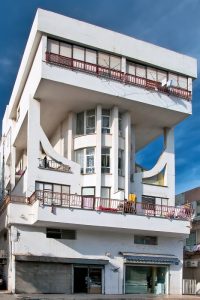Tel Aviv is home to almost 4000 Bauhaus architecture styled buildings, which makes Tel Aviv the city with the world’s most extensive collection of Bauhaus buildings. The history of Bauhaus starts during the arising of the Nazis in Germany in 1933 when the Bauhaus design school closed, and tens of thousands of German Jews fled to Israel. Hence, in Israel, there were 60000 new immigrants in a short time, urging the country to build new constructions. Among the architects who had been selected, there were six German Jews who previously studied at the Bauhaus schools in Weimar and Dessau. These architects projected and developed Tel Aviv’s White City, which is featured by the whitened exteriors. Different from other countries’ cities, Tel Aviv has Bauhaus buildings connected in the urban network. The construction of Bauhaus-styled buildings in the last century made Tel Aviv a modern UNESCO World Heritage Site in 2003.

The Bauhaus Style is also well-known as the International Style, and this architectural style had been selected primarily because of its functionality, minimalist lines and absence of embellishments. The minimalism of the Bauhaus Style was an expression of socialism-Zionism before the proclamation of the independence of the State of Israel. This architectural style was necessary to build a new city, creating a contemporary urban space for a new society. The essence of modernism was expressed through Bauhaus architecture. Indeed, it was an essential element in the foundation of the democratic State of Israel. The movement was a response to the conservative governments before World World I, particularly in Europe. Hence, the choice to avoid decorations that displayed the difference among the social classes were avoided in modern architecture and displaced by functionalism.

Moreover, the architects prefered to design flat roofs because they could be useful as an open-air social space. They also included large balconies to benefit from the Mediterranean winds and sun breakers to create shade.
One of the first movie theaters in Tel Aviv was the Cinema Ester, which is located in the Tel Aviv centre in Dizengoff Square and designed by architect Yehuda Magidowitz. It was completed in 1939, and it is situated on Zamenhof Street. Recently, the Cinema Ester had been restored, and it had been named Cinema Hotel, which is a unique International Style building featuring waved balconies and geometric windows.
The Cinema Hotel is featured by columns and pilotis supports, which elevate the building above the ground, being these structures typical of the Bauhaus style in Israel. This hotel is located in a circular public square, which is named Dizengoff Square that has been recently restored, and it represents the heart of the White City. Dizengoff Circle was designed by architect Genia Averbuch and built in the year 1938.
There are many Bauhaus buildings in Tel Aviv, and it is a delightful exploration to discover all of them, strolling around the white city.


